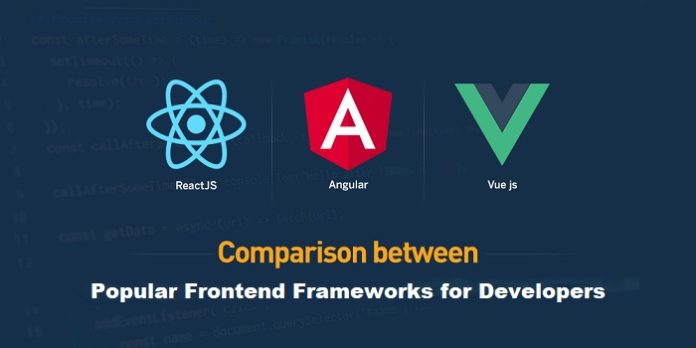User experience is the most important aspect to take care of any business developing a software application. All the features and functionalities that you are coding in your app will only be accessible to the users if your app is loading quickly and smoothly. Software with faster loading speed and enhanced user experience is created using front-end development frameworks.
The problem is not how to find a good front-end framework, the problem is to pick a suitable framework from a pile of good frameworks. Debates have been going on between expert developers over the years for which framework is the best for front-end development. Detailed comparisons are also drawn out between major contenders such as RoR vs NodeJS to determine the superiority of a framework. But instead of solving the problem, the confusion is only increasing.
So, to help you out of this pickle, allow me to present a short list of the best front-end development frameworks that are reliable and used widely around the world. Some of them are even used by tech giants to empower their products.
Top 5 front-end frameworks for developers
1. React
Although it is mostly referred to as a front-end framework, React is a JavaScript library that developers use to create interactive user interfaces.
Initially launched in 2011 by Facebook, React became open-source in 2013. Many top companies like Tesla, Netflix, Walmart, and Paypal have employed React for front-end development which further proves how reliable this tool can be.
A special JSX feature that comes with the JavaScript library allows developers to use HTML to update DOM as well as build a virtual DOM. This enhances the performance of the application. React is popular for many more things including its declarative code, reusable components, and one-way data binding structure.
Pros
- Easy to learn: Learning React framework is a piece of cake especially if you have any prior experience in JavaScript. Additionally, a variety of comprehensive tutorials are available on the internet so that you can familiarize yourself with React for front-end development.
- Usability: The React code is very easy-to-read and it can be applied to any platform. And with the low threshold, changing lanes has become quite easy.
- Fast development: React is known for reusable components. It makes only makes your development process more convenient but speeds it up too.
- Version control: Even if your code is old, you can run it without hassle in the new versions. And if there are any obsolete elements present inside it, React will prompt you to update them.
- Facebook support: Confidence in a framework will indeed increase if it is supported by a tech giant like Facebook. This also guarantees that React will have a bright future ahead.
- Large community: Apart from Facebook, React is supported by a strong community of developers around the world. You can get help with anything from ready-made solutions to expert advice on active development to solve your issue.
Cons
- Poor documentation: Although there is strong community support for development, the lack of documentation is a serious problem with React development. Frequent updates and rapid development make it harder for developers to prepare documentation.
- JSX complexity: gaining insight into the JSX feature can be very time-consuming.
If you want to create interactive visual layers for progressive web applications and single-page web apps then React is the right choice. But if you don’t have any prior experience with JavaScript programming language then it is recommended that you do not use React for front-end development.
2. Angular
Angular is also an open-source framework used for front-end development just like React.
Being created by Google in 2010, Angular is the name that you would get to see in every list of top front-end JavaScript frameworks.
No doubt, being a JavaScript-based framework, Angular comes with a promise of enhanced performance and some powerful features including two-way data binding, directives, dependencies, filters, and so on. Many business giants such as Forbes and BMW empower their applications using Angular.
Pros
- Flexibility: You won’t be limited by your browser if you are using Angular. Because it is a cross-platform framework. Also, it comes with third-party libraries that can help you compile and execute your application code under different environments.
- Third-party integrations: You can extend the development capabilities by integrating it with a wide range of Angular development tools and plugins.
- High performance: Angular framework provides an ahead-of-the-time compiler that allows you to convert your TypeScript and HTML code into JavaScript code for efficient development. This also helps ensure better security and faster loading time.
- Real-time synchronization: Angular’s two-way data binding feature ensures that the changes made in View are synchronized in Model in real-time and vice versa.
- Customization: Using the Angular framework, you can customize the components and then later reuse them in other projects as well irrespective of the fact whether it is an Angular project or not.
- Google support: Similar to React, the Angular framework is also completely maintained by a tech giant, i.e. Google, which can be considered as nothing but an advantage.
- Large community: This framework is further supported by a strong community of Angular developers from around the world.
Cons
- Hard to learn: In comparison to other front-end frameworks like Vue or React, Angular is more complicated. Even the documentation seems confusing at some points.
- Heavy: Being more complicated, Angular is heavier than other frameworks. This can harm dynamic applications. And it requires code optimization.
If you are working on a project of building enterprise-level applications with complex infrastructure then Angular is a good fit for you. It can also be used to develop multi-page apps and PWAs with dynamic content.
But remember, choose Angular only if you have any experience in developing complex web solutions. You can’t use Angular for small projects where content is static and syntax is simple.
3. JQuery
Just like React, JQuery is also a library but it is one of the oldest frameworks that is used for frontend development. Despite being initially launched in 2006, JQuery has kept up with all of its modern competitors. Many developers still consider JQuery as a framework and prefer to use it for front-end development.
Developers can optimize the interactivity of UIs by using JQuery functions like CSS, and DOM elements, and handle events and AJAX animations. Twitter, Slack, and Linkedin have also used JQuery for their products.
Pros
- Simplicity: JQuery is very easy to learn and use.
- Browser agnostic: It is compatible with every available browser.
- Vast community: With more time in the market, JQuery has also gained the support of a large and reliable community over the years.
Cons
- Outdated APIs
- Slow performance
If you are creating a simple lightweight dynamic app then you can use JQuery. But if you are working on large-scale web solutions then you shouldn’t opt for JQuery.
4. Vue.js
Another promising JavaSCript-based front-end development framework on the list is VudeJS. The long-awaited release of Vue 3.0 has fulfilled people’s expectations. It was completely rewritten in TypeScript which gives added benefits of getting smaller agile development packages and having new APIs to solve large-scale tasks. Moreover, it also supports server-side rendering which presents a lot of development opportunities.
Pros
- Easy to learn: Even the beginner can comprehend the syntax of this framework. If you have basic knowledge of CSS, HTML, and Javascript then you can get started with VueJS.
- High performance: Vue is simple and small and that’s what makes it fast and scalable too.
- Third-party integrations: You can use Vue to integrate with other projects and libraries easily.
- Virtual DOM: It is an in-built feature of VueJS that allows you to optimize the performance of the app.
- Detailed documentation: Detailed Documentation was prepared for the Vue 3.0
Cons
- Small community: The community of Vue is relatively young in comparison to other front-end frameworks like Angular and React. Also, not many tech giants prefer using this framework.
- Linguistic challenges: Many components of Vue are written in Chinese. So it would be a linguistic barrier for the developers to overcome.
You can use VueJS for creating small as well as large-scale web and mobile applications, complex single-page apps, and progressive web applications. But if you don’t have prior experience in working with this framework then you might face many issues. And the community might not always be able to help with your issues. There are some doubts related to the stability of the com[ponents too.
5. Svelte
Svelte is one of the latest front-end development frameworks. Although its initial release was in 2016, the stable version of this framework wasn’t launched until 2021. Despite being new to the market, Svelte has successfully gained the attention of developers around the world because of its new approach to UI development.
Also read: Top 15 Node.js API Frameworks For The Year 2023
Unlike other frameworks, Svelte doesn’t perform its main work in the browser but rather in the compiler at the build stage. You will only need components to upload and display on your app.
Pros
- Faster applications: Svelte allows you to combine your code with VanillaJS which makes your app work fast.
- Clear syntax: Compiling with VanillaJS also makes sure that your code is readable and reusable.
- High performance
- Suitable for beginners
Cons
- Not mature enough: The framework is still new and hasn’t spent enough time in the market to have several open-source contributions or development tools at its name. It doesn’t even have a sizable community.
If you want to build fast and small apps with a few beginner developers then Svelte might work. But if you have any major development project then it is wise to use a framework that is battle-tested and has popular support.
Conclusion
These were the top five front-end development frameworks. There are many more out there but the ones we discussed here are among the best ones. As you can already see that every framework has its strengths and weaknesses. It depends upon the project that makes one small framework worthwhile and a great tool, totally inappropriate. That is the reason why you need to identify your project requirements first and then go shop for the front-end framework that suits your needs the best.







